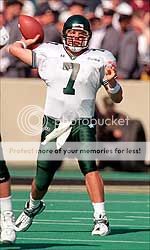Top 25 Players: #1
Looking back at the Mack Brown orchestrated renaissance of mid-80s Tulane football, I am struck at how some things never change. He rebuilt Texas the exact same way- an emphasis on mobile, athletic quarterbacks and oodles of receiving talent.
I’ve worn out the keyboard here explaining just how much harder it was for Tulane to win in that Brown era, how much broader the talent base had to be to merely be .500 as a regional independent, faving week-after-week of the SEC and other quality independents: Florida State, Louisville.
Those Mack Brown teams were loaded with skill players- beginning with the quarterback Terrence Jones. Jerome McIntosh, Michael Pierce, Melvin Ferdinand, Maurice Nelson and Larry Route were all guys who would start ahead of anyone on Tulane’s receiving corps today.
But the best was Marc Zeno- the only Tulane position player to be an All-American on this list.
#1. Marc Zeno, WR (1984-1987)
 Is that a groan I hear? This community has not taken well to ancient Tulane star players.
Is that a groan I hear? This community has not taken well to ancient Tulane star players.Still, Marc Zeno was created to catch football passes, nurtured in a perfect environment to catch said passes. A big target, tall and strong, good speed, excellent hands. He had a quarterback who could deliver the ball, a good running game to keep teams honest and a plethora of secondary receiving options to divert attention.
Still, Wally English could not find ways to get him on the field. But Brown did not suffer from that limitation of imagination. Zeno quickly became Ken Karcher’s favorite target- setting single season marks in both receptions (73) and receiving yards (1137)- including 208 yards versus LSU. Zeno would again break these same records as a senior (77 for 1206) with Jones pitching.
All those aforementioned skill players, coupled with high quality quarterbacking, turned Tulane into a pre C-USA offensive nightmare. Tulane just rolled teams on offense. The 1987 Independence Bowl team smashed every Tulane scoring record- and Zeno was particularly unstoppable. He left Tulane with the NCAA mark for career receiving yards (3725 yards). And despite a plethora of cartoon number receivers and quarterbacks that have filtered through here- he still holds Tulane’s career marks for catches and receiving yards (500+ more than Roydell Williams, about 700 more than JuJuan Dawson).
That NCAA career receiving record was no joke either. The pro-set offense had been in place for awhile- and big number offenses were percolating in the WAC and at Miami. Doug Flutie had already graduated- the college passing game was alive.
Plus, the Tulane schedule was again no joke either- littered with quality independents and BCS teams. There were no vacations for the offense- no five or six games against poor defenses, go hang 400+ yards on Rice and Army and UAB and I-AA squads.
Zeno was just consistent. With good hands and other receiving distractions present, you could just pencil him in for real good production again and again: 17 100-yard receiving games (still a record). The 100-yard day was a real achievement in the 80s. Immediate contemporaries at Tulane had a mere handful: Ursin had seven, McIntosh had five, Cook had three. Then look at these outfits Zeno put his 100-yard games up against: Washington, Iowa State, LSU (three times), Mississippi, Mississippi State (twice), Southern Miss, Kentucky, Virginia Tech, Memphis, TCU, Louisville (twice), TCU (twice). No UL-Monroe there.
He was a consensus All-American in 1987, and made some teams in 1986, the only player on this list to have two seasons of such national recognition.
After the 1987 campaign, Zeno had a poor off-season prepping for the NFL. He hurt his knee in workouts- and never was truly healthy again. The whispers went out too, and his stock plummeted- a seventh round pick of Steelers.
A seventh rounder has to impress quick or play special teams- Zeno did neither. He kicked around the CFL- but like Terrence Jones, he was a better all-around player, he lacked the great pro-skill or two. Add in some gimpiness- and he never got much chance to make a sustained impact. Teams will take a sustained chance on either a potentially great or healthy player- and Zeno was a gimpy, good one. It just became easy to give his roster spot away to a higher potential or healthier player- particularly in light of his inability to help the return game.
Labels: Tulane Top 25 Players
















